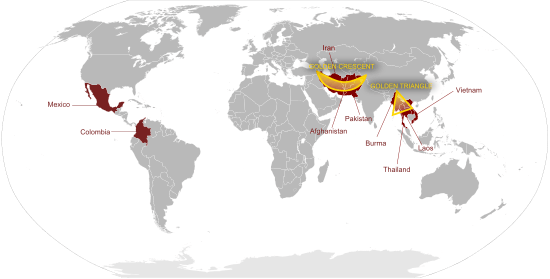Crime in Myanmar
Crime is present in various forms in Myanmar (also known as Burma).
Crime by type
Murder
In 2012, Burma had a murder rate of 15.2 per 100,000 population.[1] There were a total of 8,044 murders in Burma in 2012.[1] Factors influencing Burma's high murder rate include communal violence and armed conflict.[2]
Terrorism
Terrorism in Burma primarily consists of anti-government militant activity. Militant separatists in India, such as the United Liberation Front of Assam and the United National Liberation Front, have bases in Burma from which they launch attacks.[3]
Corruption
Burma is one of the world's most corrupt nations. The 2012 Transparency International Corruption Perceptions Index ranked the country at number 171, out of 176 countries in total.[4] The Burmese government has been making an effort to curb corruption in the country.[5]
Crime against foreigners in Burma
Crime against foreigners in Burma, although low, is a growing issue; there have been instances of both petty and violent crime in the country.[6]
Opium and methamphetamine production

Burma is the world's second largest producer of opium after Afghanistan, producing some 25% of the world's opium, and forms part of the Golden Triangle. The opium industry was a monopoly during colonial times and has since been illegally operated by corrupt officials in the Burmese military and rebel fighters,[7] primarily as the basis for heroin manufacture.
Burma is the largest producer of methamphetamines in the world, with the majority of Ya ba found in Thailand produced in Burma, particularly in the Golden Triangle and Northeastern Shan State, which borders Thailand, Laos and China.[8] Burmese-produced ya ba is typically trafficked to Thailand via Laos, before being transported through the northeastern Thai region of Isan.[9]
In 2010, Burma trafficked 1 billion tablets to neighbouring Thailand.[8] In 2009, Chinese authorities seized over 40 million tablets that had been illegally trafficked from Burma.[10] Ethnic militias and rebel groups (in particular the United Wa State Army) are responsible for much of this production; however, the Burmese military units are believed to be heavily involved in the trafficking of the drugs.[8]
The prominence of major drug traffickers have allowed them to penetrate other sectors of the Burmese economy, including the banking, airline, hotel and infrastructure industries.[11] Their investment in infrastructure have allowed them to make more profits, facilitate drug trafficking and money laundering.[12]
Prostitution
Prostitution in Burma is against the law. Prostitution is a major social issue that particularly affects women and children.[13]
Burma is a major source of prostitutes (an estimate of 20,000–30,000) in Thailand, with the majority of women trafficked taken to Ranong, a location that borders Burma at its south, and Mae Sai, which is located at the eastern tip of Burma.[14][15] Burmese sex workers also operate in Yunnan, China, particularly the border town of Ruili.[16] The majority of Burmese prostitutes in Thailand are from ethnic minorities.[15]
60% of Burmese prostitutes are under 18 years of age.[17] Burma is also a source country of sex workers and forced laborers in China, Bangladesh, Taiwan, India, Malaysia, Korea, Macau, and Japan.[18] Internal trafficking of women for the purpose of prostitution occurs from rural villages to urban centres, military camps, border towns, and fishing villages.[18]
Women are often lured into prostitution with the promise of legitimate jobs, substantially higher pay, and because their low educational levels makes it difficult for them to find jobs elsewhere. In many instances, such women come from remote regions.[19]
In addition to crimes associated with prostitution, the trafficking of women, largely to china, for Forced marriage remains a problem in Burma.[20] Lack of local brides due to China’s long standing One Child Policy is believed to fuel this trade.[21]
War crimes
The United Nations Human Rights Council has requested an investigation into potential human rights violations, or war crimes, in the country.[22]
References
- 1 2 Global Study on Homicide. United Nations Office on Drugs and Crime, 2013.
- ↑ Calderon, Justin (3 July 2013). "ASEAN: As safe as we think?". Inside Investor. Retrieved 7 July 2013.
- ↑ India seen arming Burma to counter Chinese The Washington Times
- ↑ "Myanmar still near bottom of corruption rankings in 2012 despite reforms". Thomson Reuters Foundation. 5 December 2012.
- ↑ "Burma forms committee to tackle corruption". Democratic Voice of Burma. 9 January 2013.
- ↑ "Burma (Myanmar)". travel.state.gov. Archived from the original on 20 October 2013. Retrieved 14 June 2013.
- ↑ "UN report: Opium cultivation rising in Burma". BBC. 31 October 2012. Retrieved 10 June 2013.
- 1 2 3 Thornton, Phil (12 February 2012). "Myanmar's rising drug trade". Bangkok Post. Retrieved 19 February 2012.
- ↑ McCartan, Brian (13 July 2010). "Holes in Thailand's drug fences". Asia Times. Retrieved 19 February 2012.
- ↑ Macan-Markar, Marwaan (4 January 2011). "Myanmar's drug 'exports' to China test ties". Asia Times. Retrieved 19 February 2012.
- ↑ Chin, Ko-lin (2009). The Golden Triangle: inside Southeast Asia's drug trade. Cornell University Press. pp. 239–240. ISBN 978-0-8014-7521-4.
- ↑ Lyman, Michael D.; Gary W. Potter (14 October 2010). Drugs in Society: Causes, Concepts and Control. Elsevier. ISBN 978-1-4377-4450-7.
- ↑ "2008 Human Rights Report: Burma". U.S. Department of State. 25 February 2009.
- ↑ Barry, Kathleen. The Prostitution of Sexuality. NYU Press. ISBN 0-8147-1277-0.
- 1 2 "WOMEN". Burma: Country in Crisis. Soros. October 2005. Retrieved 11 January 2007.
- ↑ Kyaw Zwa Moe (2005). "Yunnan's Sin City". The Irrawaddy. Retrieved 2 July 2008.
- ↑ Hughes, Donna M. "Burma/Myanmar". Factbook on Global Sexual Exploitation. University of Rhode Island. Retrieved 11 January 2007.
- 1 2 "V. Country Narratives -- Countries A through G". Trafficking in Persons Report. Retrieved 11 January 2007.
- ↑ Chelala, Cesar. "Women, prostitution, and AIDS". THE STATE OF WOMEN AND CHILDREN'S HEALTH. Retrieved 11 January 2007.
- ↑ "humantrafficking.org". Retrieved 1 February 2016.
- ↑ "Websites Sell Burmese Brides to Chinese Bachelors". The Irawaddy. 12 December 2012. Retrieved 1 February 2016.
- ↑ Tisdall, Simon (11 March 2010). "UN calls for war crimes investigation in Burma". Guardian.